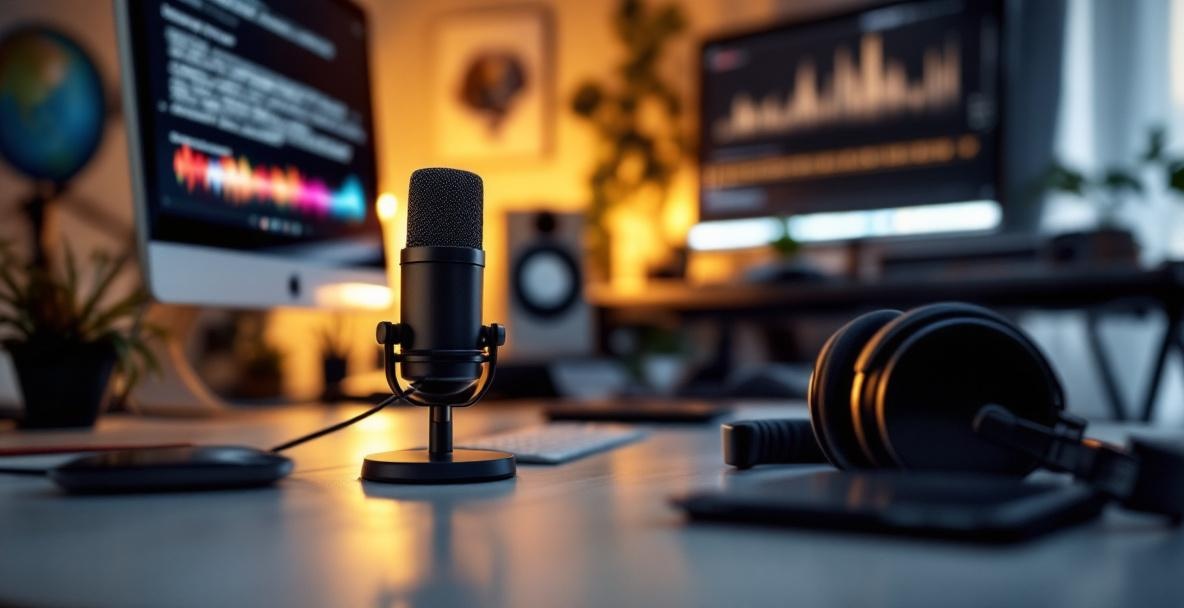Podcasting is a tough game, and every creator wants to get their message out there. Podcast transcription turns your audio into text, opening doors for better growth and real engagement. We have seen how a solid transcript not only makes your work more visible but also connects you with fans who might miss your message if they rely solely on audio.
Why Podcast Transcripts Really Matter

Transcripts can make a huge difference. They turn spoken words into text, making your episodes easier to find and enjoy. Transcription helps more people understand and share your work. Many podcasters concentrate only on sound, which may cause them to miss out on listeners who prefer written content. Without a transcript, you risk losing valuable connections with those searching for your message online. As research from GoTranscript shows, podcasts are booming, and creators who include transcripts enjoy a clear advantage in building both their audience and brand.
Opening Doors: Making Podcasts Truly Inclusive

Transcribing your show is one of the best ways to ensure everyone can enjoy your content. Nearly 466 million people face hearing challenges worldwide, and without a written version, your podcast stays out of reach for many. Offering a transcript invites all listeners to join the conversation and shows that you value an inclusive environment. When you add a transcript, you also help those who have difficulty processing spoken words but can easily follow the text.
Being accessible does more than feel right; it works well for your show. At Castee, we see that podcasters who put accessibility first often enjoy a wider and more engaged fan base. Showing you care about every listener builds trust and encourages loyalty.
Expanding Your Reach
Using transcripts can bring your podcast to new listeners beyond just those who need them for hearing reasons. It suits different ways people enjoy content and fits a variety of situations that may arise when you offer audio only. If English is not a person's first language, reading along can make the content much clearer and easier to follow. When you cover tough or technical subjects, having the text on hand makes everything simpler to understand. Sometimes, it is simply not possible for someone to listen to an episode-whether they are in a noisy café, a quiet library, or a silent office. A transcript lets your audience catch up on your show when audio isn’t an option. Often, people like to get a sneak peek before they dive in. A transcript lets potential listeners skim through to decide if the episode matches what they are searching for.
Boost Your SEO and Let Listeners Find You
Search engines only read text, so they miss all your spoken words. Without a transcript, your valuable content stays hidden from those looking on Google or Bing. Transcripts are a brilliant way to help fans find your work by giving the search engines more to index. Turning your episodes into text gives search engines something they can crawl and rank. Every transcript acts like a detailed article filled with keywords and useful details that boost your visibility. Recent research from LexiForge.ai proves that transcripts can seriously improve your chances of being found online. Using transcripts often brings more visitors to your site because they provide extra text for search engines to index, opening many paths for new listeners beyond just traditional directories or social media.
Using Keywords to Your Advantage
Transcripts do more than open your words to search engines. They let you naturally incorporate important keywords that match what your audience is searching for. If you cover topics your listeners care about, the transcript will include the phrases they often type into search bars, making it easier for your show to pop up during online searches. For example, if you dive into digital marketing strategies for small businesses, your transcript will include these terms and help boost your ranking. Transcripts also let you connect different parts of your site together. By linking episodes and related posts, you build a content network that search engines love. Better internal links can boost your site’s overall ranking and highlight your most important topics. Before recording your episode, think about the valuable search terms your fans use. These natural inclusions help create a transcript that is both reader-friendly and optimized for search engines.
Best Ways to Create Quality Podcast Transcripts

Turning your audio into text is easy, but crafting a quality transcript takes a bit more work. When you follow a few essential tips, you can ensure that your transcript is accurate, easy to read, and truly helpful for your audience. Timing is important-publish your transcript at the same time as your episode so that everyone sees them together. This way, search engines can index both at once, and you won’t have a backlog of untranscribed shows. Quick posting keeps your content fresh and available. Good formatting makes a big difference too; a long block of text can turn off readers. Break your transcript into clear sections by topic, add timestamps, and note who is speaking in conversations. Clear formatting makes it much easier for your audience to navigate the content. Think about where your transcript will live on your site. Whether it’s its own blog post, hidden beneath your audio player, or offered as a downloadable PDF, choose the setup that best fits your website and improves user experience.
Finding a Transcription Service That Fits
When getting your transcript done, you have several choices-from automated tools to hiring experts. Your decision depends on your budget, quality needs, and available time, so it is worthwhile to weigh your options carefully. Automated tools are quick and budget-friendly, perfect for crystal-clear audio and large volumes of episodes. Services like Otter.ai, Descript, and Rev's automatic transcription offer decent results but sometimes stumble on specialized terms or overlapping speakers. Automated services are convenient, though they have their limits. If you hire a human transcriber, you typically get much better results, catching all the details and producing a polished transcript. This is ideal for interviews with experts or discussions that cover tricky subjects. High accuracy might justify the extra cost. Many podcasters mix the two methods by starting with an automated transcript and refining it by hand. This balanced approach often gives you the best of both worlds.
Do It Yourself or Hire Pros?
Deciding whether to do your own transcripts or hire someone depends on your routine and needs. Consider factors like time, cost, and your production workflow to make the choice that fits best. Doing it yourself can be rewarding if you have the time and a knack for detail. With simple audio tools and shortcuts to pause and rewind, you can keep costs down while handling shorter episodes or enlisting help from your team. On the other hand, letting professionals work on your transcripts can free up many hours. Outsourcing means you can focus on creating great content while experts take care of the transcription. Professional transcription services excel at managing overlapping voices, technical lingo, and background noise. Think about the overall return on this investment rather than just the price tag. Your time, accuracy, and how well transcripts work with your strategy all matter. Many successful podcasters find that a little extra spending now leads to greater benefits later in terms of SEO and audience growth.
Turning Transcripts Into More Exciting Content
Your transcript is more than just extra text; it can be a treasure trove for new content. Many podcasters know how to turn a transcript into blog posts, social media snippets, and more. Repurpose your transcript to keep your episodes alive in different forms and reach a wider group of listeners. The trick is to mine the best parts of your transcript and focus on memorable quotes, surprising statistics, or clear explanations that stand out. Once you spot these gems, you can convert them into content for your blog or social channels, drawing in more people. Having a clear plan for repurposing makes each transcript even more valuable. A single episode can yield extra material that fills your content calendar and keeps your fans engaged between new releases.
Turning Transcripts Into Blog Posts
Turning your transcript into a blog post is a smart way to boost your content’s reach. A well-organized written version of your episode attracts readers who enjoy text and improves your SEO efforts. Begin by breaking your transcript into logical sections with clear headings. You might need to rearrange parts of the conversation to keep it smooth and reader-friendly. Write an introduction that highlights the key points, and finish with a summary or clear call to action inviting readers to learn more about your work.
Enhance your post with supporting visuals, such as images or charts, to bring your transcript to life. Include links to the resources mentioned during the conversation and connect to other related posts. This tactic not only makes your post more engaging but also strengthens your internal linking, which is great for SEO. Many podcasters find that blog posts crafted from their transcripts feel more genuine and are easier for readers to connect with than standard articles. An authentic voice really sets your content apart.
Crafting Social Media Snippets
Your transcript is a goldmine for social media content. Extract compelling quotes and key insights to create posts that drive traffic back to your full episodes. Find short, strong statements in your transcript that capture the essence of your episode. These snippets can be transformed into eye-catching graphics using tools like Canva or Adobe Express. Add your podcast branding and be sure to include a call to action so people know where to go for the full story. Sometimes bold or surprising comments spark the best buzz online, encouraging discussion and shares. Always include a link to the episode so curious followers can hear more. Optimized snippets are a simple way to keep your social channels lively and engaging.
Wrapping It Up: What to Do Next
Transcripts are not a luxury; they are essential if you want to grow your fan base and make a real impact with your podcast. With inclusive transcripts, you make your content more reachable, improve your SEO, and open up new ways to reuse your work. The secret is to weave transcription into your regular production and planning processes. When you think about adding transcripts, balance quality, cost, and speed. Whether you choose an automated solution, hire a pro, or mix both methods, the best move is to just start. Work on your latest episodes first, and then update your older content as you can. Take the first step toward growing your audience today.
Ready to boost your podcast with quality transcripts and smart content reuse? Visit Castee today to see how our full-spectrum podcast marketing solutions turn your transcripts into powerful tools for growing your audience, improving your SEO, and building a loyal community around your content.
Leave a Reply